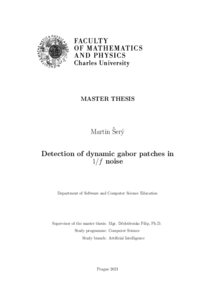Detection of dynamic Gabor patches in 1/f noise
Detekce dynamických Gaborových vlnek v 1/f šumu
diplomová práce (OBHÁJENO)

Zobrazit/
Trvalý odkaz
http://hdl.handle.net/20.500.11956/124658Identifikátory
SIS: 222986
Katalog UK: 990024256350106986
Kolekce
- Kvalifikační práce [11342]
Autor
Vedoucí práce
Oponent práce
Pilát, Martin
Fakulta / součást
Matematicko-fyzikální fakulta
Obor
Umělá inteligence
Katedra / ústav / klinika
Katedra softwaru a výuky informatiky
Datum obhajoby
4. 2. 2021
Nakladatel
Univerzita Karlova, Matematicko-fyzikální fakultaJazyk
Angličtina
Známka
Výborně
Klíčová slova (česky)
detection|modeling|1, f noise|Gabor patchKlíčová slova (anglicky)
detection|modeling|1, f noise|Gabor patchResearch focusing on static scenes with static objects is omitting the time factor from real life examples we are trying to study. Can we say that a lifeguard looking for a drowning man is using the same brain processes that were observed in the laboratory for static scenes? We can conclude that a static scene is a big simplification of the task itself. The aim of this thesis is to prepare a tool which would allow researching dynamic scenes and thus broadening the possibilities of visual detection tasks at hand. Along the tool we also present a couple of simplified examples with which we would like to demonstrate the utilization of the tool. All concluding with a final experiment in which we will try to detect masked patterns in a noisy environment. 1
Research focusing on static scenes with static objects is omitting the time factor from real life examples we are trying to study. Can we say that a lifeguard looking for a drowning man is using the same brain processes that were observed in the laboratory for static scenes? We can conclude that a static scene is a big simplification of the task itself. The aim of this thesis is to prepare a tool which would allow researching dynamic scenes and thus broadening the possibilities of visual detection tasks at hand. Along the tool we also present a couple of simplified examples with which we would like to demonstrate the utilization of the tool. All concluding with a final experiment in which we will try to detect masked patterns in a noisy environment. 1
